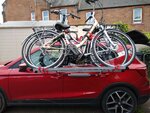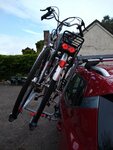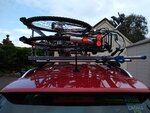- Mar 14, 2005
- 19,272
- 4,459
- 50,935
Hello again Peter,I have a newly purchased 2019 Sterling Eccles 590 fitted with a rear mounted bike rack and tow with a RR Sport.The Thule bike rack has a max load of 60kg which will exceed the combined weight of my two electric bikes at approx 50kg .My question is ,how do you lift them onto the rack ? Has anybody any experience of towing with electric bikes on the rear mounted rack ?
I think you can assume that no one else has towed with electric bikes on the rear of a caravan, otherwise I'm sure they would have commented by now. What you have received is the wisdom of several caravanners who have had differnt experiences, and in particular the concern shown for what in the UK is not a widespread practice of rear mounted bike racks.
Where your question differs is your intention to use electric bikes, and I and I am sure others have assumed such bikes will typically weigh more than normal bikes and will thus make your plan more extreme than if it had been ordinary bikes.
Quite clearly there is a market for rear mounted bike racks. They are quite common on the continent, but not so common here in the UK. There are a number of reasons why the practice is less common here than abroad.
Many UK caravans do not have the necessary body strength to carry a rack and bikes, so obviously its a no-no for them. But some caravan manufacturers do make provision for racks on some of their models - check with the dealer or manufacturer for details about each specific model.
Generally UK specification caravans have more internal fittings and home comforts than continental vans which uses up more payload capacity, which obviously might preclude the additional weight of bike and rack.
There seems to be a preference for continental caravans to have longer drawbar length. This tends to make them tow with slightly better stability characteristics, and that should accommodate the additional end loading of a bike rack with less risk.
If the caravan manufacturer has made provision for a rear mounted rack, they will also have specified the maximum load that can be hung from the rear wall. Don't forget that would be the weight of the bikes including the weight of the rack. - would that still be within the caravan manufactures weight limit?
I haven't checked but I suspect the caravan manufacturer will not have designed the actual rack, and will either offer an off-the-shelf rack as an option, or expect the owner to source their own rack. In either case, do not assume the load capacity of the rack is the same as the maximum load capacity of the caravans rear wall - Always check.
The video's that have been linked to this thread that demonstrate instability due to load distribution should be a wake up call to caravanners, but the videos are an very extreme example to demonstrate the yaw inertia effect. Caravans don't have half their weight at the ends and no weight in the middle, so it is possible to tolerate some end loading, but it is better and safer to avoid it if you can. Incidentally the full report that spawned this demonstration clearly links yaw inertia and speed to trailer instability.
If the figures add up for you fine - try it, but no one here can offer a copper bottomed guarantee that your particular outfit will be fine.
My personal concerns are, with the weight of the rack and the bikes at the rear, you may need to add substantially more load at the front of the caravan to achieve a sensible nose load figure, and that increases the yaw inertia even more.
Last edited:




